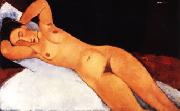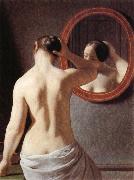
Oil On
Canvas, Real Flavor of Old Masters
|
Eliseu Visconti
|
|||
|
|
|||
| 1867-1944 Eliseu Visconti Gallery Brazilian painter and decorative artist, of Italian birth. He was taken as an infant from Italy to Rio de Janeiro. In 1884 he began studying in Rio de Janeiro at the Academia Imperial das Belas Artes and the Liceu Imperial de Artes e Of?cios under Victor Meirelles de Lima, Henrique Bernardelli (1837-1946) and Rodolfo Amoedo (1857-1941). He was active in efforts to eliminate the academy's rigid academic discipline. He went to Paris in 1892 and attended the Ecole des Beaux-Arts and the Ecole des Arts D?coratifs, where he was taught by Eug?ne-Samuel Grasset. At the 1900 Exposition Universelle in Paris, Visconti won a silver medal for the paintings Youth (1898) and Dance of the Wood Nymphs (1899; both Rio de Janeiro, Mus. N. B.A.). Following the Pre-Raphaelites, his main influences were Botticelli and other painters of the Italian Renaissance, but he was also affected by Grasset and Art Nouveau. On his return to Brazil, among the works exhibited in 1901 in Rio de Janeiro were a series of ceramic objects with Brazilian floral motifs and designs for postage stamps. His florid style began to give way to Impressionism in the stage curtain, circular ceiling panel and proscenium frieze he executed for the Rio de Janeiro Teatro Municipal (1906-7; in situ). In 1906 he became director of painting at the Escola Nacional de Belas Artes in Rio de Janeiro. | |||
|
|
|||
| This artist (Eliseu Visconti) is not available now. | |||
|
|
|||
|
Amedeo Modigliani
|
|||
|
|
|||
| Italian Expressionist Painter and Sculptor, 1884-1920 Amedeo Clemente Modigliani (July 12, 1884 ?C January 24, 1920) was an Italian artist of Jewish heritage, practicing both painting and sculpture, who pursued his career for the most part in France. Modigliani was born in Livorno (historically referred to in English as Leghorn), in northwestern Italy and began his artistic studies in Italy before moving to Paris in 1906. Influenced by the artists in his circle of friends and associates, by a range of genres and art movements, and by primitive art, Modigliani's œuvre was nonetheless unique and idiosyncratic. He died in Paris of tubercular meningitis, exacerbated by poverty, overworking, and an excessive use of alcohol and narcotics, at the age of 35. | |||
|
|
|||
|
|
Nude Amedeo Modigliani70.jpg Painting ID:: 10609 Visit European Gallery |
1917, oil on canvas, 28 3/4 x 45 7/8 ins (73x116.7 cm). The Solomon R. Guggenheim Museum, New York, Gift of Solomon R. Guggenheim, 1941. | |
Height Width |
INS/CM |
||
|
X |
|
||
|
|
|||
|
Christoffer Wilhelm Eckersberg
|
|||
|
|
|||
| Danish Neoclassical Painter, 1783-1853 Danish painter and teacher. He has been called 'the father of Danish painting' because of the influence he exerted on Danish painters in the second quarter of the 19th century. With Christen K?bke he was the leading painter of the Danish 'Golden Age' (c. 1800-1850). | |||
|
|
|||
|
|
Nude new9/Christoffer Wilhelm Eckersberg-498533.jpg Painting ID:: 33917 Visit European Gallery |
mk87 c.1837 Oil on canvas 32x25cm Copenhagen,Den Hirschsprugske Samling | |
Height Width |
INS/CM |
||
|
X |
|
||
|
|
|||
|
Edvard Munch
|
|||
|
|
|||
| Norwegian 1863-1944 Edvard Munch Locations Edvard Munch (pronounced , December 12, 1863 ?C January 23, 1944) was a Norwegian Symbolist painter, printmaker, and an important forerunner of expressionistic art. His best-known composition, The Scream is one of the pieces in a series titled The Frieze of Life, in which Munch explored the themes of life, love, fear, death, and melancholy. Edvard Munch was born in a rustic farmhouse in the village of Adalsbruk in Loten, Norway to Christian Munch, the son of a prominent priest. Christian was a doctor and medical officer, who married Laura Cathrine Bjølstad, a woman half his age, in 1861. Edvard had an older sister, Johanne Sophie (born 1862), and three younger siblings: Peter Andreas (born 1865), Laura Cathrine (born 1867), and Inger Marie (born 1868). Both Sophie and Edvard appear to have gotten their art talent from their mother. Edvard Munch was related to painter Jacob Munch (1776?C1839) and historian Peter Andreas Munch (1810?C1863). The family moved to Kristiania (now Oslo) in 1864 when Christian Munch was appointed medical officer at Akershus Fortress. Edvard??s mother died of tuberculosis in 1868, as did Munch's favorite sister Johanne Sophie in 1877. After their mother's death, the Munch siblings were raised by their father and by their aunt Karen. Often ill for much of the winters and kept out of school, Edvard would draw to keep himself occupied. He also received tutoring from his school mates and his aunt. Christian Munch also instructed his son in history and literature, and entertained the children with vivid ghost stories and tales of Edgar Allan Poe. Christian??s positive behavior toward his children, however, was overshadowed by his morbid pietism. Munch wrote, ??My father was temperamentally nervous and obsessively religious??to the point of psychoneurosis. From him I inherited the seeds of madness. The angles of fear, sorrow, and death stood by my side since the day I was born.?? Christian reprimanded his children by telling them that their mother was looking down from heaven and grieving over their misbehavior. The oppressive religious milieu, plus Edvard??s poor health and the vivid ghost stories, helped inspire macabre visions and nightmares in Edvard, who felt death constantly advancing on him. One of Munch's younger sisters was diagnosed with mental illness at an early age. Of the five siblings only Andreas married, but he died a few months after the wedding. Munch would later write, "I inherited two of mankind's most frightful enemies??the heritage of consumption and insanity." Christian Munch??s military pay was very low, and his attempts at developing a private side practice failed, keeping his family in perrenial poverty. They moved frequently from one sordid flat to another. Munch??s early drawings and watercolors depicted these interiors, and the individual objects such as medicine bottles and drawing implements, plus some landscapes. By his teens, art dominated Munch??s interests. At thirteen, Munch has his first exposure to other artists at the newly formed Art Association, were he admired the work of the Norwegian landscape school, and where he returned to copy the paintings, and soon he began to paint in oils. | |||
|
|
|||
| This artist (Edvard Munch) is not available now. | |||
|
|
|||








